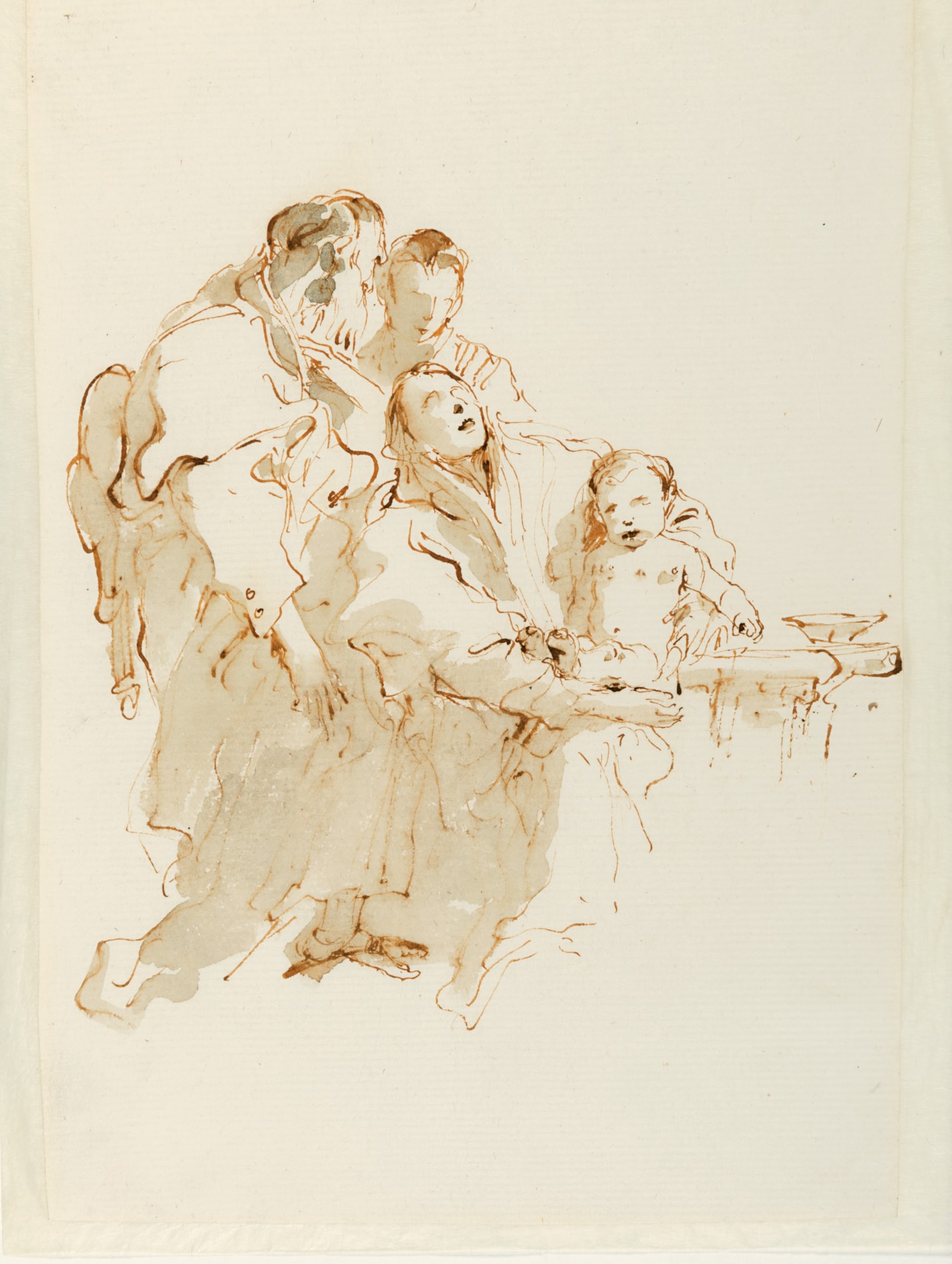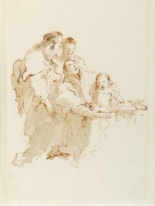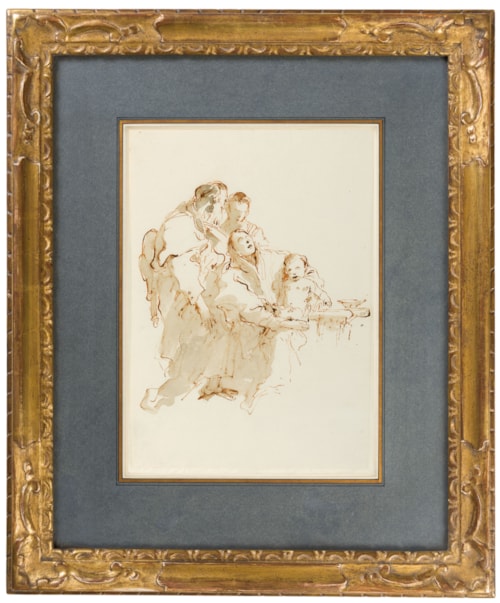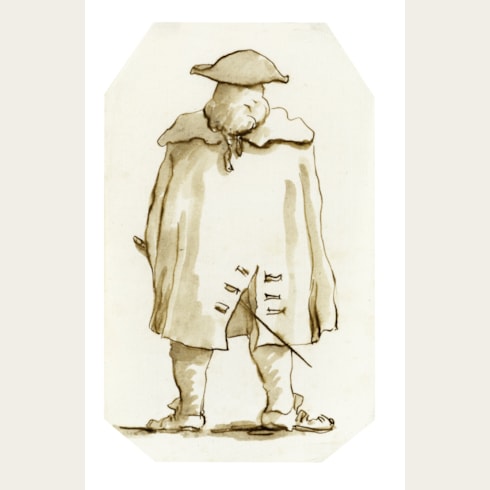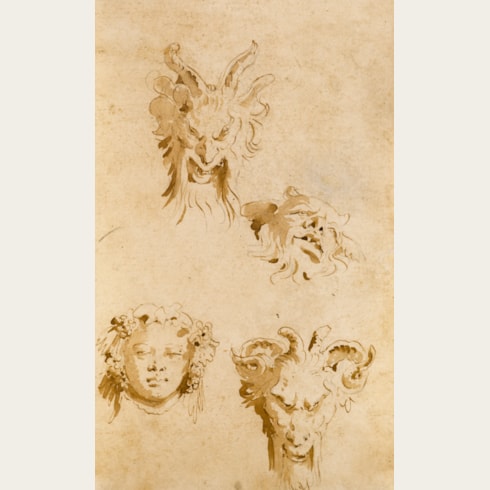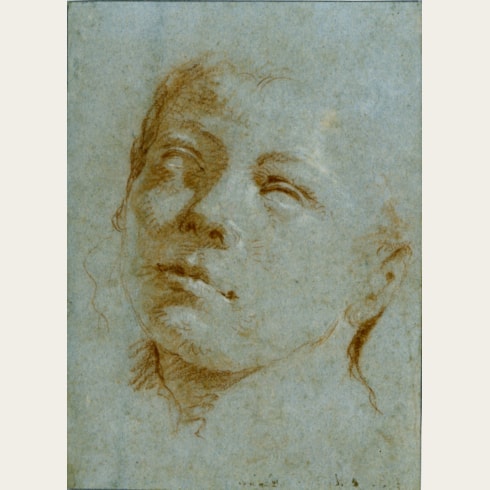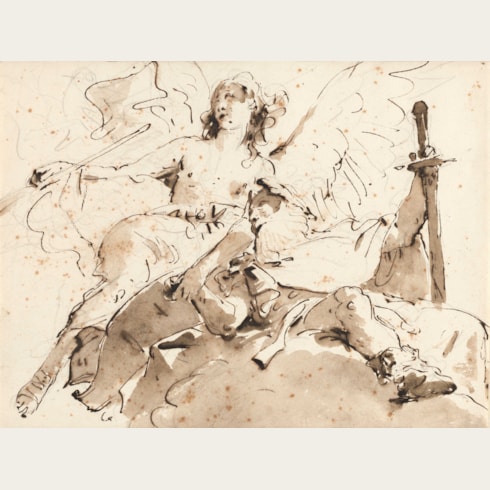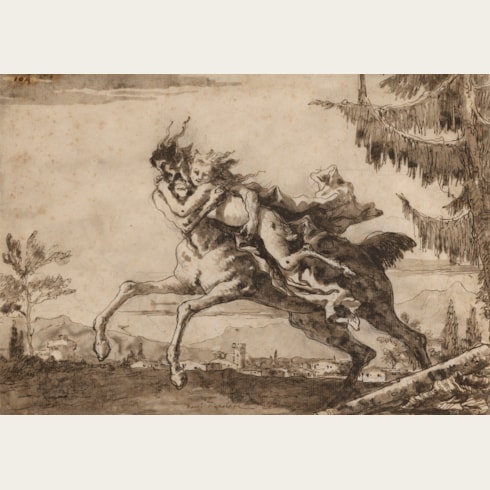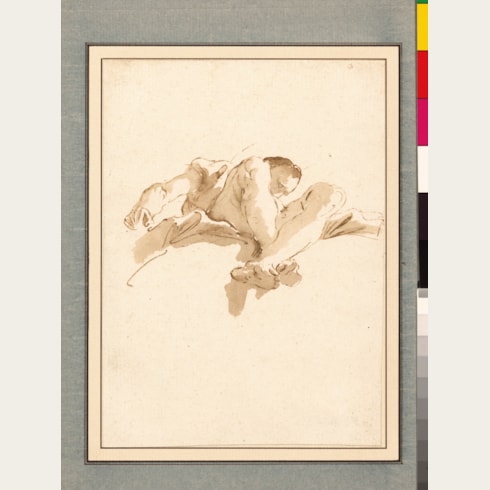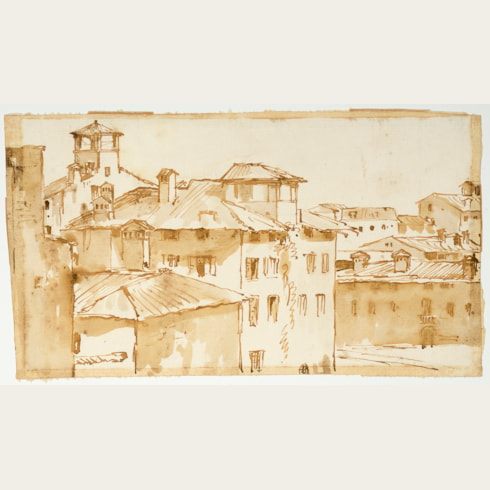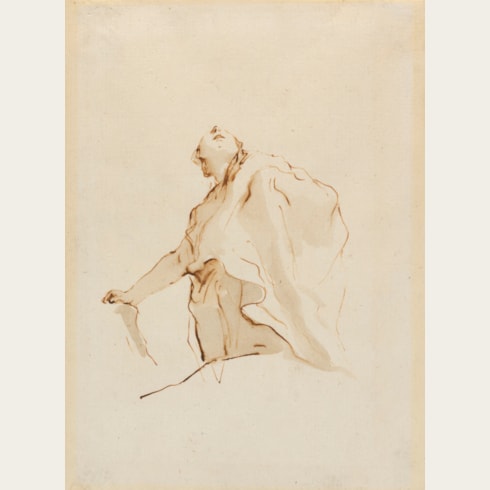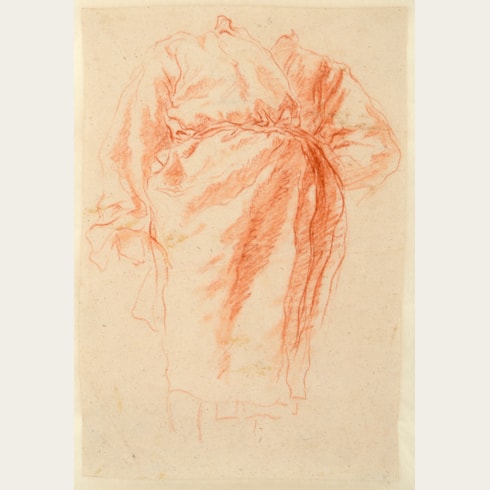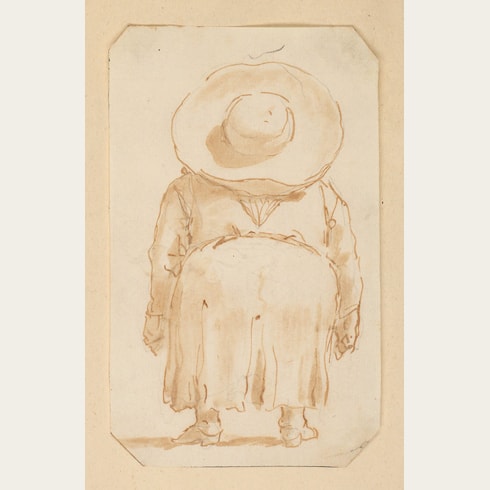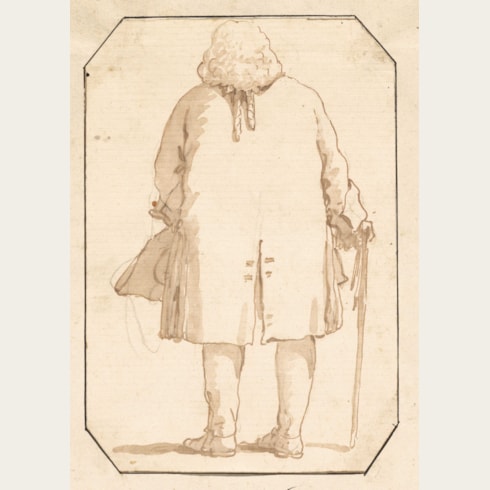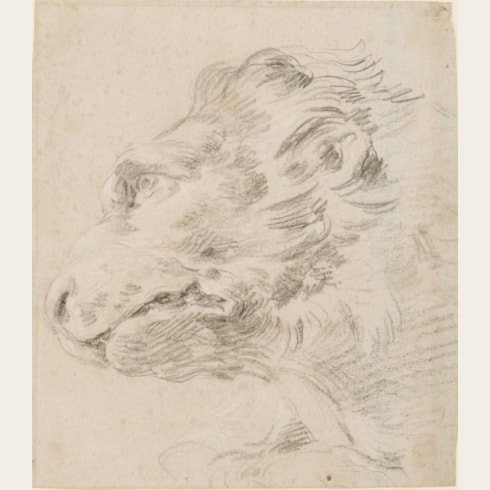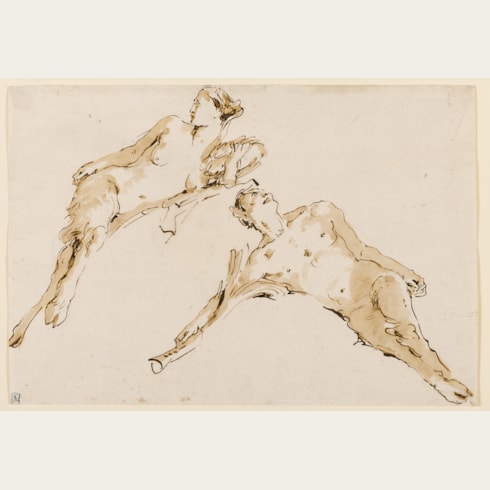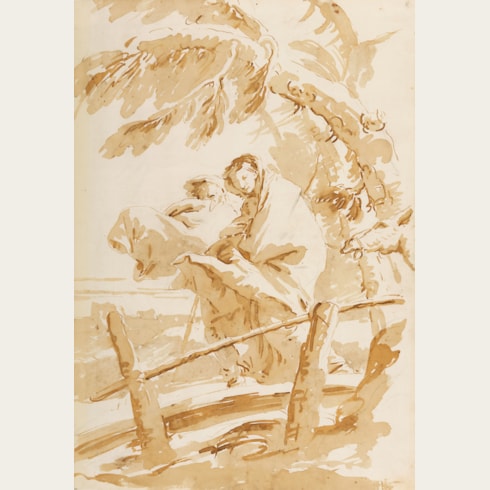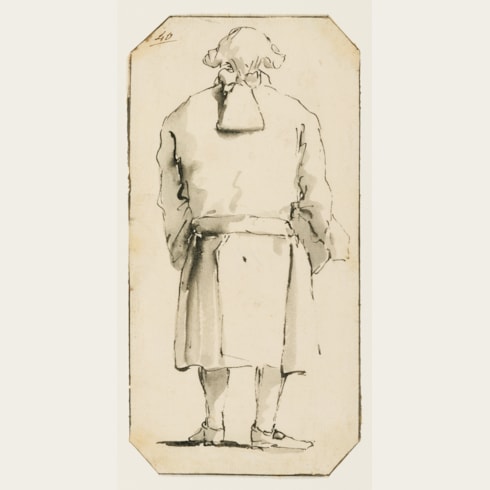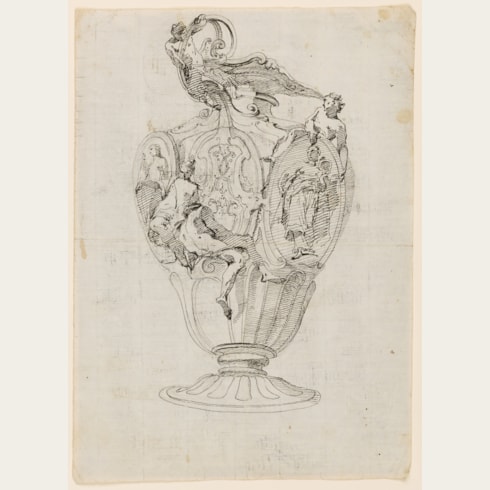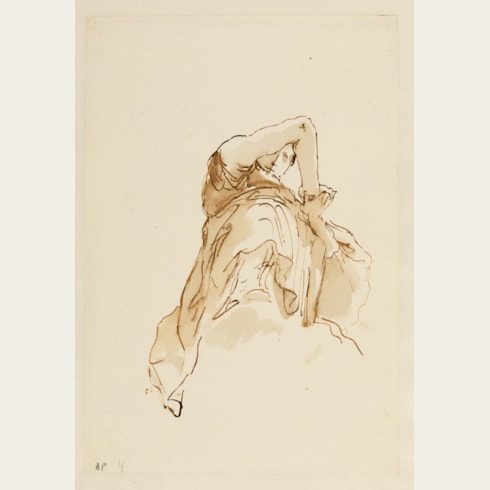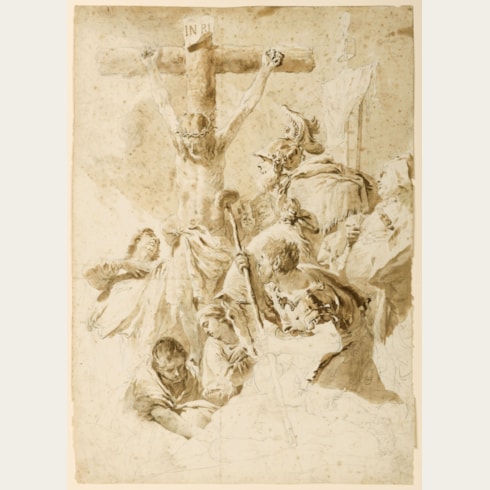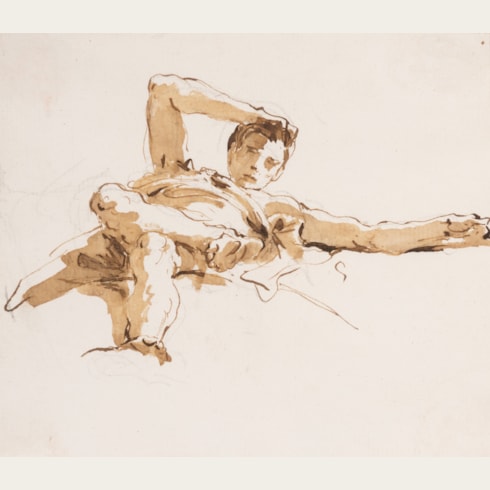Giovanni Battista TIEPOLO
(Venice 1696 - Madrid 1770)
The Holy Family
284 x 204 mm. (11 1/8 x 8 in.)
The Padri Somaschi convent at Santa Maria delle Salute was suppressed in 1810, and the album of which this drawing was a part may have found its way into the possession of Count Leopoldo Cicognara (1767-1834). The album then passed through several Venetian collections, including that of the noted sculptor Antonio Canova (1757-1822), who seems to have owned a large number of drawings by Tiepolo, some of which were purchased around 1810 from Margherita Moscheni (1754-1823), the widow of Domenico Tiepolo. The ‘Holy Family’ album eventually entered the extraordinary collection of Tiepolo drawings assembled by the English writer, collector, amateur watercolourist and sometime resident of Venice, Edward Cheney (1803-1884), of London and Shropshire, who was the most significant collector of Giambattista Tiepolo’s work in the middle of the nineteenth century. The album was later inherited by Cheney’s nephew, the photographer Alfred Capel Cure (1826-1896), by whom it was sold at auction in 1885. The album was eventually broken up and the drawings dispersed in England and France in the late 1920s. Other drawings from this album are today in the Kupferstichkabinett in Berlin, the Art Institute of Chicago, the National Gallery of Scotland in Edinburgh, the Courtauld Gallery in London, the Los Angeles County Museum of Art, the Metropolitan Museum of Art and the Pierpont Morgan Library in New York, the Ashmolean Museum in Oxford, the Museum Boijmans Van Beuningen in Rotterdam, and elsewhere.
As has been noted of these drawings of the Holy Family, ‘This motif offered the artist endless possibilities, working with broad washes over wiry pen lines, often over the slightest preliminary chalk sketch. For this theme, Tiepolo favored a very fine white paper, occasionally large in scale…The role of the paper became increasingly important in accentuating the drama of the scenes, underscoring the freshness and spirit of these imaginative works.’ Although it has been suggested that these drawings might have been intended as models for Tiepolo’s sons Domenico and Lorenzo, none of them appear to have been used for paintings. They seem instead to have been executed purely for their own sake, possibly while Giambattista was suffering from gout, which limited his activities as a painter.
As Adelheid Gealt has written of this series of drawings, ‘Giambattista’s love of theme and variation, which found expression in his Flight into Egypt series in the 1730s, focused on a new subject, the Holy Family, in the late 1750s to 1760…Giambattista took up the essential drawing implements of chalk, pen and ink and explored the visual possibilities offered by the three figures who make up the Holy Family (the Virgin Mary, Saint Joseph, and the baby Jesus). With sufficient time on his hands, Giambattista never ran out of ideas for variants, producing a series of around seventy-five drawings…all of them ranked among the finest drawings of his career.’
As Gealt further notes, ‘With no repetition of composition, Giambattista considered such basic questions as who would hold the baby Jesus (choosing Mary most often, as would be expected, but sometimes affording Joseph the opportunity). Giambattista also varied the placement of the three figures relative to one another and the viewer, sometimes placing Jesus between his mother and earthly father, sometimes placing him in the foreground...Jesus has many attitudes – sleeping, gazing at his visitors, hugging his mother, or smiling at his father. Joseph is protective, adoring, or distracted. Mary is tenderly maternal or calm and serene, the center of all other activities. Other characters are sometimes added: often Jesus’s cousin Saint John the Baptist is shown as a playmate…Angels, solo or in groups, are sometimes present as assistants or simply to lend a sacred tone to the proceedings…All of these distinctive variations are achieved with the simplest of means: an initial idea sketched out in chalk, then defined and amplified by swift, assured marks of the pen and brilliant washes that use the white of the paper to mark highlights – truly the hallmark of a gifted draftsman. How long did it take to make them? It would be hard to say, but seventy-five drawings would probably have taken the artist several months, if not longer.’
In the words of an early 20th century scholar, the Holy Family drawings ‘are simply unrestrained ideas, thrown off by the happy fancy of the painter according to his own inclination, without any practical intention. The work of Tiepolo abounds in imaginative sketches of this kind, which were never turned to account in painting…Typical in all of [these drawings] is the method of handling in broken, nervous, rapid strokes of the pen, now fleeting lightly over the surface of the paper, now halting and spreading for a moment, under greater pressure of the hand, effectively suggesting a pictorial contrast of dark and light. Typical, too, the light indication of the shadows, with great washes of diluted sepia; and the great empty space left free in the backgrounds, with perfect propriety of tone-relation, and a surprising effect of airiness.’
Adriano Mariuz has noted that ‘Much of the intimate and personal art produced by Giambattista Tiepolo towards the end of his career has to do with domestic life and affection. Perhaps the most perfect expression of this is to be found in the wonderful series of variations on the theme of the Holy Family…They are diverse in composition and treatment, but together express almost every possible aspect of family love and emotion. His pen traces the bonds of affection uniting the Virgin, the infant Jesus and the elderly Joseph, with the spontaneity and the pure beauty of an arabesque.’ Similarly, as George Knox has aptly described these pen drawings, ‘They are the most magnificently sustained examples of Giambattista’s graphic inventiveness. Everything suggests that they were made entirely for their own sake, without reference to any projected painting. They float on the page like exquisite arabesques, a marvelous monument to Giambattista’s talent and virtuosity as a draughtsman.’
The leading painter in Venice for much of his career, Giambattista Tiepolo was also undoubtedly one of the finest Italian draughtsmen of the 18th century. That his drawings were greatly admired in his lifetime is confirmed by contemporary accounts; indeed, as early as 1732 the writer Vincenzo da Canal remarked that ‘engravers and copyists are eager to copy his works, to glean his inventions and extraordinary ideas; his drawings are already so highly esteemed that books of them are sent to the most distant countries’. From the late 1730’s until his departure for Spain in 1762, Tiepolo enjoyed his most productive period as a draughtsman, creating a large number of vibrant pen and wash studies that are among the archetypal drawings of the Venetian Settecento. As one recent scholar has commented, ‘From the start of his career [Tiepolo] had enjoyed drawing as an additional means of expression, with equally original results. He did not draw simply to make an immediate note of his ideas, nor to make an initial sketch for a painting or to study details; he drew to give the freest, most complete expression to his genius. His drawings can be considered as an autonomous artistic genre; they constitute an enormous part of his work, giving expression to a quite extraordinary excursion of the imagination; in this respect, Tiepolo’s graphic work can be compared only with that of Rembrandt.’
Tiepolo’s drawings include compositional studies for paintings and prints, drawings of heads, figure studies for large-scale decorations, landscapes and caricatures, as well as several series of drawings on such themes as the Holy Family. Many of these drawings were bound into albums by theme or subject, and retained by the artist in his studio as a stock of motifs and ideas for use in his own work, or that of his sons and assistants.
Provenance
Giuseppe Maria Tiepolo, the monastery of the Padri Somaschi, Santa Maria della Salute, Venice
Probably Giovanni Domenico Tiepolo, Venice, until 1804
Probably by descent to his widow, Margherita Moscheni, Venice
Possibly Conte Leopoldo Cicognara, Venice
Antonio Canova, Venice, by c.1810
By descent to his half-brother, Monsignor Giovanni Battista Sartori-Canova, Possagno
Francesco Pesaro, Venice
Purchased from him in 1842 by Edward Cheney, London and Badger Hall, Badger, Shropshire
By descent to his nephew, Col. Alfred Capel Cure, of Badger Hall, Badger, Shropshire and Blake Hall, Ongar, Essex
His sale, London, Sotheby’s, 29 April 1885, part of lot 1024 (nine volumes of drawings, bt. Parsons for £15)
E. Parsons and Sons, London
Possibly a private collection (Earls of Ranfurly?), Ireland
William Fagg, Sydenham
Messrs. B.T. Batsford, London
Their sale, London, Christie’s, 14 July 1914, part of lot 49 (three volumes of drawings, bt. Parsons for £120)
E. Parsons and Sons, London
Richard Owen, Paris, by whom the album broken up and dispersed
Probably Savile Gallery, London, in 1928
The present sheet in a private collection, Paris, by 1971
Anonymous sale, Paris, Artcurial, 30 March 2011, lot 50
Arturo Cuéllar-Nathan, Zurich.
Literature
Exhibition

